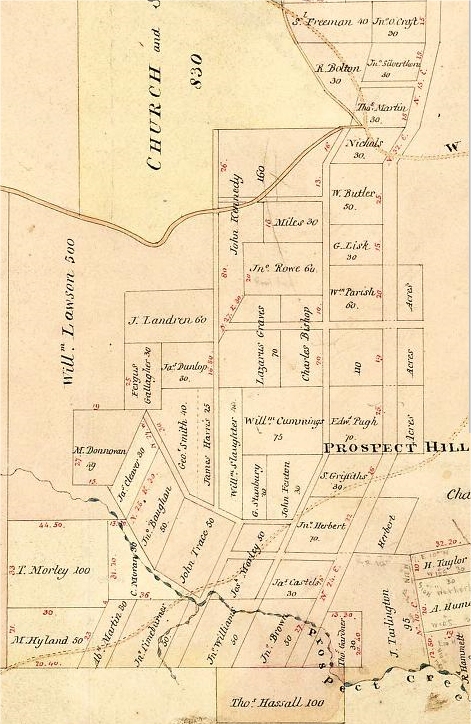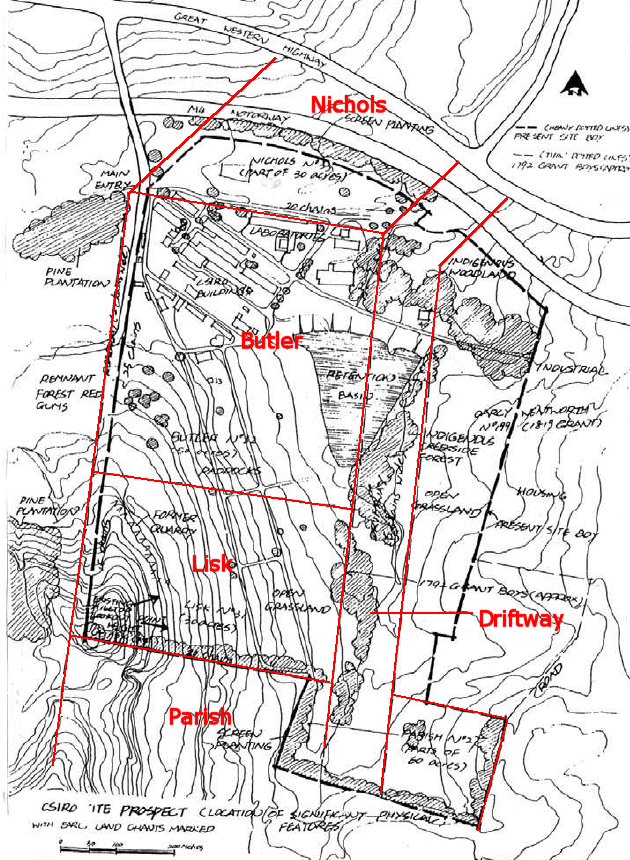The first group of settlers at Prospect Hill
By 1791 the government farm at Parramatta had about 400 acres of crops planted, mostly maize. In that year Governor Arthur Phillip started granting small plots of land (mostly 30 to 70 acres) to emancipated convicts. Some convicts had spent years in prison and prison ships in England before being transported. Some of them who were under seven-year sentences were therefore near to completing them. The first to be granted land was James Ruse who was given a plot known as Experiment Farm at Parramatta in 1789. An acre and a half of the ground was cleared for him and a hut built. He continued to receive rations from government stores for eighteen months. After that period he became independent of such support and, according to the agreement, the land became his own.
As the experiment with James Ruse seemed to be promising success, thirteen grants of land at Prospect Hill were made to emancipated convicts in July 1791 on similar conditions. On 5th December 1791, just a few months after the land grants, Watkin Tench visited the community and reported on its progress, before he finally left New South Wales to return to England. He lists the grantees in geographical order from north to south as they are shown on map below (except that he writes Marlow for Morley, and William Kilby's grant, just south of William Parish's, was soon to be taken over by Charles Bishop). Through Tench we have a full description of the Prospect Hill settlement soon after its establishment:
... I determined to visit all the private settlers to inspect their labours, and learn from them their schemes, their hopes and expectations.
In pursuance of my resolution, I crossed the country to Prospect Hill, at the bottom of which live the following thirteen convicts, who have accepted allotments of ground, and are become settlers.
| Men's names | Trades | Number of acres in each allotment | Number of acres in cultivation | |
|---|---|---|---|---|
| John Silverthorne | Weaver | 40 | 1¾ | |
| Thomas Martin | Weaver | 40 | 1½ | |
| John Nichols | Gardener | 40 | 2 | |
| William Butler, and his wife | Seaman | 50 | | 4* | |
| ________ Lisk(1) | Watchmaker | | 40 | ||
| William Parish, wife and a child | Seaman | 60 | 2¾ | |
| William Kilby, and his wife | Husbandman | 60 | 1¾ | |
|
Edward Pugh, wife and two Children | Carpenter | 70 | 2½ | |
| Samuel Griffith | Butcher | 40 | 1½ | |
| John Herbert** | ||||
| James Castle | Husbandman | 40 | 2 | |
| Joseph Marlow*** | 46 | |||
| John Williams, and his wife | Carpenter | 50 | 1 | |
* In partnership
** Not out of his time; but allowed to work here at his leisure hours, as he has declared his intention of settling
*** In a similar predicament with Herbert.
The terms on which these allotments have been granted are: that the estates shall be fully ceded for ever to all who shall continue to cultivate for five years, or more; that they shall be free of all taxes for the first ten years; but after that period to pay an annual quit-rent of one shilling. The penalty on non-performance of any of these articles is forfeiture of the estate, and all the labour which may have been bestowed upon it. These people are to receive provisions, (the same quantity as the working convicts), clothes, and medicinal assistance, for eighteen months from the day on which they settled.
To clear and cultivate the land, a hatchet, a tomahawk, two hoes, a spade and a shovel, are given to each person, whether man or woman; and a certain number of cross-cut saws among the whole. To stock their farms, two sow pigs were promised to each settler, but they almost all say they have not yet received any, of which they complain loudly. They all received grain to sow and plant for the first year. They settled here in July and August last. Most of them were obliged to build their own houses; and wretched hovels three-fourths of them are. Should any of them fall sick, the rest are bound to assist the sick person two days in a month, provided the sickness lasts not longer than two months; four days labour in each year, from every person, being all that he is entitled to. To give protection to this settlement, a corporal and two soldiers are encamped in the centre of the farms, as the natives once attacked the settlers and burnt one of their houses. These guards are, however, inevitably at such a distance from some of the farms as to be unable to afford them any assistance in case of another attack.
With all these people I conversed and inspected their labours. Some I found tranquil and determined to persevere, provided encouragement should be given. Others were in a state of despondency, and predicted that they should starve unless the period of eighteen months during which they are to be clothed and fed, should be extended to three years. Their cultivation is yet in its infancy, and therefore opinions should not be hastily formed of what it may arrive at, with moderate skill and industry. They have at present little in the ground besides maize, and that looks not very promising. Some small patches of wheat which I saw are miserable indeed. The greatest part of the land I think but indifferent, being light and stoney. Of the thirteen farms ten are unprovided with water; and at some of them they are obliged to fetch this necessary article from the distance of a mile and a half. All the settlers complain sadly of being frequently robbed by the runaway convicts, who plunder them incessantly. (Tench 1793, Ch. 16).
The single men were each granted 30 acres, those with wives 50 acres, plus 10 acres for each child. Wide strips of bush called driftways were created between each pair of land blocks to allow for communication routes. However the driftways had the unfortunate effect of providing cover for attackers whether escaped convicts who wished the raid the settlers' stores or the original inhabitants of the area who resented the settlers' disruption of their means of subsistence.

Prospect Parish Map n.d. Source: NSW Lands Dept map no. 140726
No doubt the land boundaries were initially defined by being staked out on the ground. At some stage a rough survey would have been undertaken and a map drawn to show the grants. The details were then repeatedly copied as the maps were updated, so that the original land grantees' names (except William Kilby who was replaced Charles Bishop in 1801) were still being shown with their grant boundaries on maps of the early twentieth century. Later grantees have been added to the map but the original ones can be seen to be situated in a north-south linear strip of land from John Silverthorne's grant (now part of Fox Hills Golf Course) in the north, along the eastern slope of Prospect Hill and then curving westwards round its southern slopes to the grants of Joseph Morley (shown as Jospeh Marlow in Tench's table) and John Williams.
|
